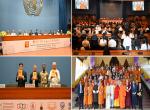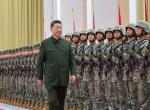Japan’s ruling Liberal Democratic Party (LDP) picked its new leader in a poll on 29 September who shall be sworn in as Japan’s 100th Prime Minister when Parliament convenes on 4 October. Since the LDP has a majority in both the Lower and Upper Houses, going through the Diet process is all but a formality. The winning candidate is the former Foreign Minister Fumio Kishida. When Kishida is officially sworn in on 4 October, he shall lead the party into a general election that must be called by November as the four-year terms of the current members of the Lower House are due to expire on 21 October.
There were surprises galore on Kishida’s triumph over his rivals the vaccination czar Taro Kono and the present Administrative Reforms Minister, former Internal Affairs Minister Sanae Takaichi and LDP executive acting Secretary-General Seiko Noda. Several opinion surveys had shown that Kono shall score over others. However, all indicators proved wrong. Issues that took centre stage were on gay marriage, the right of married couples to use different surnames, pension reforms, need for Covid-19 hard lockdown measures, bureaucratic reforms, the possession of nuclear submarines, and the acquisition of first-strike capability against enemy bases among other things. When Kishida officially assumes office, he will be taking important decisions on how to steer domestic and foreign policy with Japan potentially becoming either more hawkish or dovish on defence, and more liberal or conservative in terms of social policies.
What led to the swing in favour of Kishida? Earlier, a poll by Nikkei and TV Tokyo showed Kono as the preferred choice with 46 per cent support, with Kishida coming second with 17 per cent, even below Takaichi with 18 per cent in the Mainichi survey. Kono was backed by Suga as well as the popular former Defence Minister Shigeru Ishiba and Environment Minister Shinjiro Koizumi, the son of former Prime Minister Junichiro Koizumi.
The election process in Japan is a bit different than other democracies. There were 764 votes at stake. Each of the LDP’s 382 lawmakers in the Diet get one vote each, while the other half is split among Japan’s 47 prefectural chapters where rank and file members also get a say. Unless a candidate wins more than half of the votes in the first round, the top two finishers go into a run-off election where 429 ballots are at play. In this case, the 382 lawmakers and 47 prefecture chapters get one vote each. Though Kono won the most number of votes in the first round, boosted by rank-and-file grassroots support, he fell short of the 50 per cent for a decisive win. Thus a run-off was held, in which Kishida with little public backing, won in a second round of voting over a maverick rival Kono. Kishida defeated his chief rival Kono by 257 to 170 votes dominated by the party’s members of Parliament. Neither the public nor the rank-and-file members of the party had shown much support for Kishida but the conservative wing of the party, which dominated the Diet, preferred Kishida over Kono, who was in charge of Japan’s vaccine rollout. The final choice of a party stalwart who lacked in public opinion to be the country’s next Prime Minister was a surprise.
The Diet shall hold a special session on 4 October to officially elect the new prime minister, merely a formality for Kishida to be catapulted to the prime minister’s chair. Kishida will lead the party in a general election that must be held no later than the end of November.
Kishida’s tasks are cut out. Being aware of public dissatisfaction of the predecessor Suga administration, Kishida promises to introduce a “new capitalism” and encourage companies to distribute more of their profits to middle class workers.1
What made the leadership election this time special? For the first time two women vied for the top post, though unsuccessfully. Sanae Takaichi, 60, a hard-line conservative was backed by Shinzo Abe, Japan’s longest-serving Prime Minister. Seiko Noda, 61, a left-leaning lawmaker who called for more rights for women, the elderly and those with disabilities was the other women candidate. Both were eliminated in the first round itself. This was expected. In fact, Noda had already conceded by remarking that it could be anyone but not me.
Normally, elections in countries such as Russia, Iran or Hong Kong raise curiosity. But it is unusual that Japan, which is a parliamentary democracy and the world’s third-largest economy, a single party has governed for all but four years since 1955, hogs world attention. Also, LDP’s victory in the next election due by the end of November is a foregone conclusion. The LDP which oversaw Japan’s rapid growth during the 1960s and 1970s helped it to solidify its power. The people, despite being critical to some of LDP’s policy stances, feel obliged to LDP’s contribution to the nation’s economic growth and peoples’ welfare.
The immediate task before Kishida at this delicate time would be to attend to the struggling economy, how to reinvigorate it, and navigate an often troubled relationship with neighbours. If Kono’s performance as the vaccination czar, which according to Fortune, was “a bright spot in an otherwise deteriorating COVID-19 response” did not assuage the feeling of the people who could not condone Kono’s efforts to stopping the deaths of more than 17,000 people, Kishida’s task would be much taller than Kono’s and he must raise the bar to meet with the people’s expectations.
The positives that could back Kishida is that Japan is on track of fighting against the pandemic, though progress on economic recovery has faltered a bit following the long national emergency to curb the spread of the virus. Thus Kishida inherits a soft economic recovery. His immediate tasks on the economic front would be focussed on long-term structural issues facing the country, such as stagnant wages, a growing wealth gap, long-delayed digitisation efforts and lack of opportunities for women in the work force.
In the foreign policy domain, territorial disputes and bitter memories relating, in particular to South Korea, could pose challenges for Kishida to deal with. Related with bitter memories are also trade issues. North Korea’s nuclear and missile developments/tests would be new anxieties. As regards relations with South Korea, both are at loggerheads with neither willing to concede an inch from their positions, leaving the ties frosty.
But the biggest challenge for Kishida would be how to deal with China, Japan’s largest trading partner and a potential source of regional instability because of its aggressive posturing on territorial issues on South and East China Seas and Taiwan. It is possible that Kono’s dovish attitude towards China and willing to patch up ties with South Korea went against his cause. This is in contrast to Takaichi’s ultraconservative and full-throated commitment to standing up to Beijing and an unapologetic attitude toward Japan’s wartime history. Yet, attitude towards women and unwilling to accept a woman as the head in a male-dominated society led to quick elimination of Takaichi and Noda.
Insofar as India is concerned Kishida is likely to continue with bolstering bilateral relationship and strengthen its ongoing relationship with the Quad members.
Endnotes:
(The paper is the author’s individual scholastic articulation. The author certifies that the article/paper is original in content, unpublished and it has not been submitted for publication/web upload elsewhere, and that the facts and figures quoted are duly referenced, as needed, and are believed to be correct). (The paper does not necessarily represent the organisational stance... More >>
Image Source: https://media.pri.org/s3fs-public/styles/story_main/public/images/2021/09/2021-09-29-japan-pm.jpg?itok=2aAQkxVy











Post new comment